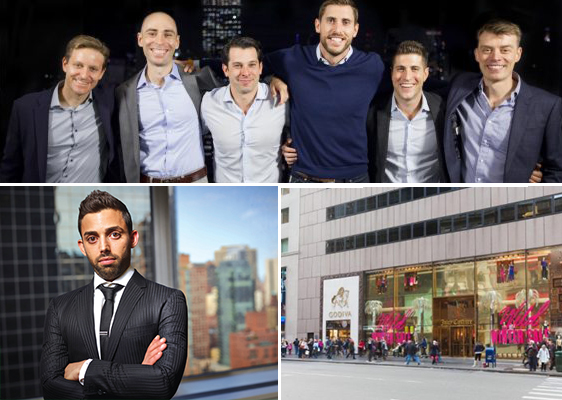In many Eastern societies, the arranged marriage is still a thing. A bride and groom are stacked up on paper, and if enough boxes — family wealth, background, education, status — line up, a match is struck.
The $300 million merger between VTS and Hightower, announced last week, seems like the perfect arranged marriage. Both offer landlords and brokers a chance to manage their portfolios on the cloud, allowing users to track rent rolls, analyze leasing velocity and monitor in-progress deals. Both are based in New York, and cater to the same client base. And both have shown a talent for raising large amounts of venture capital. As one company, they’ll have the majority of the market, and with their combined investor base (Trinity Venture Partners, Thrive Capital, Blackstone Group) can acquire complementary companies.
“It creates an opportunity to roll up many different startups in CRE tech under this umbrella,” MetaProp’s Zach Aarons told The Real Deal about the deal.
But a merger is also a marriage of personalities, and judging by that, the companies are quite far off. VTS is known for its surfer brah culture — both founders grew up chasing waves and a poster from the original “Point Break” film adorns the office — and its hyper-aggressive, sales-driven growth. At least until recently, the company had a rule that if an employee wanted to blow off some steam with a push-up session, everyone had to join in.
Hightower, on the other hand, is known more as a product-driven firm. Many sources in the industry give it the edge for having the slightly more sophisticated platform, and its soft-spoken CEO Brandon Weber has largely steered clear of shouting from the rooftops about the company’s success.
In fact, Hightower execs had always challenged one of VTS’ key metrics: the square footage it claims to have on its platform. This number, according to VTS, ballooned from 850 million square feet in September 2014 to over 2 billion square feet in January 2015 and crossed 3 billion square feet by September of this year. Hightower had said VTS was being over-aggressive in its representation, counting all client space even if it wasn’t actively being managed on the platform. When asked how many square feet his own firm represented, Weber would always demur, arguing that it was much more important to look at metrics such as customer retention. Indeed, in its bio, Hightower never disclosed how many square feet it handled.
But in their joint statement last week, the company announced a “collective customer base of over 5 billion square feet.” The Hightower name is the first casualty of the merger, with the combined firm to be called VTS. It appears that Hightower’s more measured approach to self-promotion will be the next one.

From left: Richard Baxter, Yoron Cohen and Scott Latham
Colliers scores JLL’s top I-sales trio: In 2010, Cushman & Wakefield lost its top capital markets team of Richard Baxter, Jon Caplan, Yoron Cohen and Scott Latham to JLL. Cushman never quite recovered: It has been a bit player in the trophy investment sales space since then, though since late 2014 it’s made several big moves to fix that, such as the acquisition of Massey Knakal and the hiring of Doug Harmon and Adam Spies.
It’s now JLL’s turn to deal with their exit. This morning, Colliers announced it has poached Baxter, Cohen and Latham, its most aggressive move yet to become a big player in New York. The trio helped bring JLL to fifth place in TRD’s investment sales ranking, with $2.9 billion in deals in 2015. Cohen, for example, represented Olayan Group in its $1.4 billion purchase of the Sony Building. Colliers, by contrast, ranked 19th with $527 million in deals. Jon Caplan is also planning to leave JLL to pursue other opportunities, possibly as a real estate investor, sources said.
It’s another sign that brokerage bosses are willing to shell out a lot of money for the cadre of top talent who handle the sale of New York’s trophy towers — it’s exceedingly rare for a non-brand-name broker to secure a listing for such a building, and with a record amount of money flowing into commercial real estate brokerage, there’s a lot of pressure to make things happen.
Toledano wants big payday in the East Village: “When you go from zero to 60 in three seconds, sometimes you exceed the speed limit,” Raphael Toledano once proclaimed. He was referring to the flurry of lawsuits relating to his surprise $140 million acquisition of a 28-building East Village portfolio from the Tabak family. Toledano declared his intent to hold on to the portfolio, which he purchased in a heavily-leveraged transaction (128 percent), for life and pass it on to his children.
Yet after a settlement with tenants and a failed ice-cream social, “Rafi” appears to have had a change of heart. He’s now shopping 13 of the buildings in the portfolio for $160 million. He had paid about $76 million for the properties, according to city records, which means he’s looking to more than double his money in a little over a year.

From left: Marc Holliday, Jeff Sutton and the retail space at 650 Fifth Avenue
Nike kicks market into frenzy with 650 Fifth deal: The city’s sputtering retail market needed a boost, and it got one with the news of Nike’s whopping $700 million deal at 650 Fifth Avenue, the retail space owned by Jeff Sutton and SL Green Realty. Nike’s new store will occupy the lower level and the first six floors of the tower, and is slated to take up between 60,000 and 70,000 square feet. At a party at the Ainsworth on the evening the news of the deal came out, brokers expressed astonishment at the terms of the lease, which includes a starting rent of $4,000 per foot on the ground floor. One, referring to Sutton, said: “I don’t know how the fuck he does it.”
(Paydirt is a weekly column that riffs on the biggest NYC real estate news of the moment, providing analysis and historical context on the deals and players that make this town tick. Read more from Paydirt here.)
